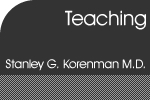

|
<< Previous Section | < Previous Page | Next Page > | Next Section >>
Bibliography (page 3 of 13) Bodenheimer, T. (2000). "Uneasy Alliance -- Clinical Investigators and the Pharmaceutical Industry." N Engl J Med 342(20): 1539-1544. The author details the uncomfortable relationship between clinical investigators who carry out research on new drugs and industry that has a powerful vested interest in the success of their products. Conflicts of interest are widespread with adverse consequences for the science. Boyd, E. A. and L. A. Bero (2000). "Assessing Faculty Financial Relationships With Industry: A Case Study." JAMA 284(17): 2209-2214. The authors reviewed disclosure forms at UCSF to determine more about clinical and basic science faculty relationships with industry. By 1999, almost 7.6% of faculty investigators reported personal financial ties with sponsors of their research, including paid speaking engagements 34%. 33% had consulting agreements, and 32% involved the investigator holding a position on a scientific advisory board or board of directors. 14% involved equity ownership, and 12% involved multiple relationships. The advisory panel recommended managing perceived conflicts of interest in 26% of the cases. They considered this to be a growing problem that required management. Boyd, E. A., M. K. Cho, et al. (2003). "Financial Conflict-of-Interest Policies in Clinical Research: Issues for Clinical Investigators." Acad Med 78(8): 769-774. They questioned faculty at UCSF and Stanford who conducted clinical research about their knowledge of and attitudes towards conflict of interest policies. The campus COI policies were a mystery to more than half of those interviewed. Many investigators felt that, rather than the university, monitoring COIs was the job of professional societies, (who have no clout) the public (that understands nothing about this) and, individual investigators (who routinely engage in self-deception) should monitor conflicts of interest. Administrators and policymakers is have to find a way to convince investigators, both clinical and nonclinical, of the serious problems of bias and co-option associated with financial relationships with industry. Brainard, J. (2001). Federal Rules on Conflicts of Interest in Biomedical Research Are Inadequate, GAO Finds. The Chronicle of Higher Education. Washington. The GAO pointed out what everyone knew and was glad of, namely that COI regulations were weak and unenforceable. Bramstedt, K. (2003). "Research subject advocates: to whom are they loyal?" Clin Invest Med 26(2): 64-9. The author deals with the issue of conflicts of interest in the activities of Research Subject Advocates. This is based largely on who is paying them. Of course, the main issue is what are they paying them for. GCRC RSAs, for example are paid to support the subjects and they should normally operate in that manner. She deals with the Abiomed artificial heart case in which the subject advocate was sued as wrongly representing the institution. How hard is it for subjects to get the kind of support they need in difficult studies with considerable risk? Brownlee, S. (2004). Doctors Without Borders: Why you can't trust medical journals anymore. Washington Monthly. This reporter discusses the Nemaroff case in which a physician wrote a review article for Nature Neuroscience in which he failed to reveal his many and profitable conflicts of interest in recommending drug treatments for psychiatric illness. She goes on to discuss in vivid terms the insidious downside of these conflicts and the great efforts made by industry to involve prominent physicians in supporting their drugs. Calfee, J. E. (2001). "Pharmaceutical Price Controls and Patient Welfare." Ann Intern Med 134(11): 1060-1064. He argues forcefully against price controls for drugs as inhibiting innovation and eliminating the risk capitol necessary to bring new ideas to market by killing incentive. << Previous Section | < Previous Page | Next Page > | Next Section >> |
Chapter 4 Quick Links Conflicts of Interest (COI) Definitions Consequences of a COI Government Intervention Industry Sponsorship Professional Societies Clinical Practice Guidelines Other Initiatives COI in Financial Consulting Cases Bibliography Chapter 4 Download (PDF) |